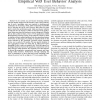Free Online Productivity Tools
i2Speak
i2Symbol
i2OCR
iTex2Img
iWeb2Print
iWeb2Shot
i2Type
iPdf2Split
iPdf2Merge
i2Bopomofo
i2Arabic
i2Style
i2Image
i2PDF
iLatex2Rtf
Sci2ools
ICDCSW
2008
IEEE
2008
IEEE
On Feasibility of P2P On-Demand Streaming via Empirical VoD User Behavior Analysis
—In its current art, peer-to-peer streaming solution has been mainly employed in the domain of live event broadcasting. In such a paradigm, users are required to simultaneously participate the streaming, which yields tremendous bandwidth pool to alleviate the server load. However, little effort has been paid to study the performance gain when peer-to-peer solution is deployed into the domain of Video-on-Demand (VoD) applications, when users have the freedom to access a large pool of media files at their preferred times. Users of VoD applications exhibit file-dependent and time-varying access patterns, which are hard to simulate without realistic guidance from the operational system observation. In this paper, we present an empirical study on the traces collected by the Vanderbilt University media streaming service over a period of 8 months. We pay special attention to peer aggregation around one media file, in which peer-to-peer streaming is able to play an essential role. With th...
Distributed And Parallel Computing | ICDCSW 2008 | Peer-to-peer Streaming | Peer-to-peer Streaming Solution | Server Load |
| Added | 30 May 2010 |
| Updated | 30 May 2010 |
| Type | Conference |
| Year | 2008 |
| Where | ICDCSW |
| Authors | Bin Chang, Liang Dai, Yi Cui, Yuan Xue |
Comments (0)

